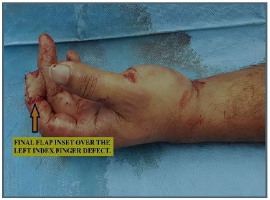A 41 year old gentleman sustained a partial amputation of the left index fingertip with composite soft tissue loss of the radial 1/3rd at the distal phalanx level. A decision was made to reconstruct the defect with an innervated cross finger flap, and the plan was executed, the flap was divided after two weeks. The patient was followed up to 1 year, and he reported a score of 8/10 in terms of satisfaction with treatment outcome on VAS scale, two-point discrimination of 4.9 mm of the affected fingertip, QuickDASH score of 4.5 and no donor site morbidity.
Numerous methods of fingertip reconstruction have been described. They include local flaps such as volar V-Y advancement flap, regional flaps such as cross-finger and neurovascular island flap, distant pedicled flaps like groin flap and abdominal flaps, and free flaps such as partial toe pulp flaps or toe transfers [1]. To overcome the weakness of the traditional cross finger flap in terms of poor sensory recovery, the innervated cross finger flap was proposed [2]. To obtain a satisfactory sensory recovery, two-point discrimination of 8mm or less is required for optimal function of the finger [1,2].
This technique involves using a laterally based flap raised from the dorsum of the ulnar sided fingers. During flap elevation, the dorsal sensory branch of the proper digital nerve is isolated and included in the flap. Finally, neurorrhaphy between the dorsal sensory nerve and proper digital nerve (pulp branch) in the recipient finger defect is done under a microscope with 9-0 or 10-0 nylon. The donor area on the dorsum is resurfaced with a full-thickness skin graft harvested from the hypothenar or wrist crease area. Sucur et al. reported a similar technique for thumb tip reconstruction using the superficial terminal branch of radial nerve with near-normal sensibility [3].
The innervated cross finger flap is a useful means of resurfacing fingertip defects with pulp soft tissue loss and has the added advantage of good sensibility and functional outcome.


